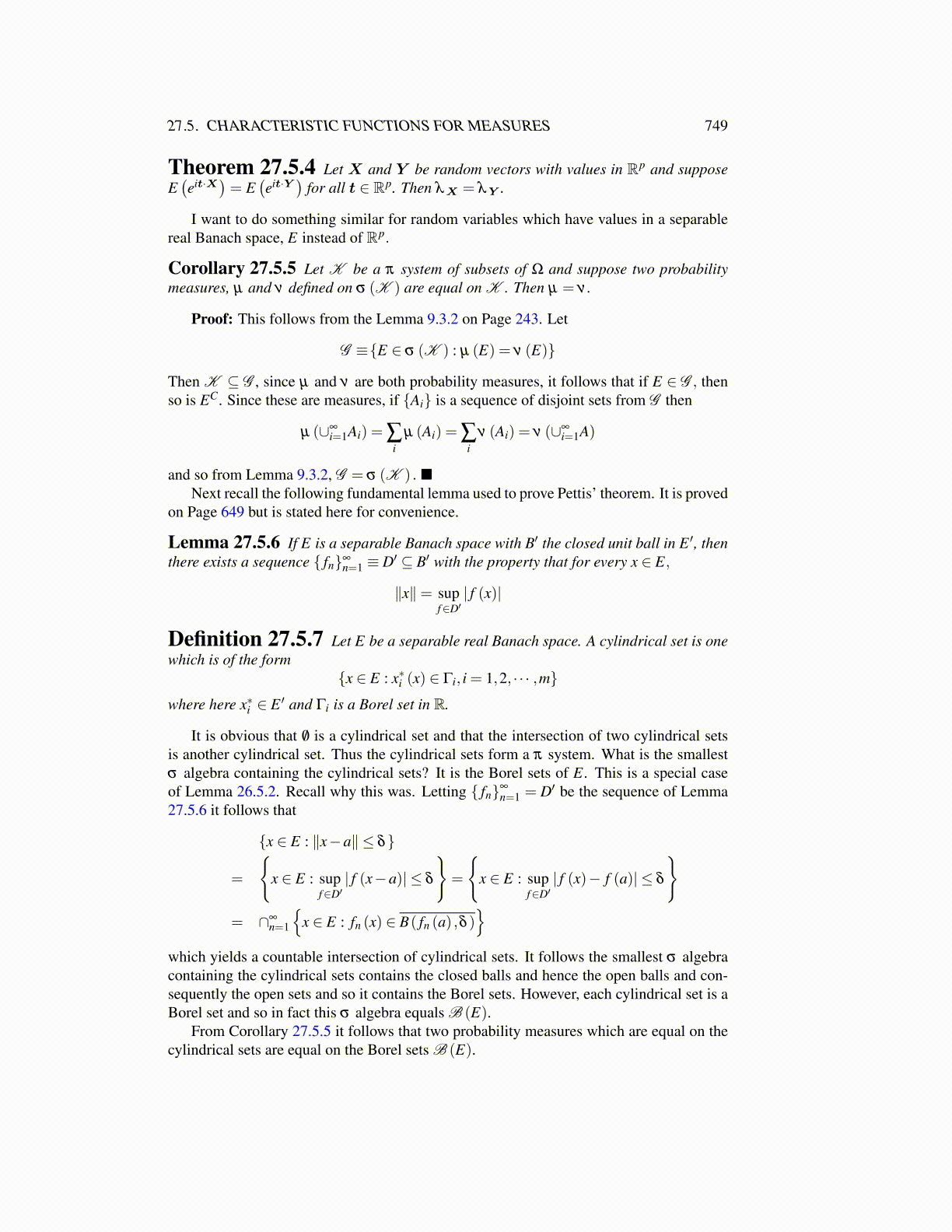
27.5. CHARACTERISTIC FUNCTIONS FOR MEASURES 749
Theorem 27.5.4 Let X and Y be random vectors with values in Rp and supposeE(eit·X) = E
(eit·Y ) for all t ∈ Rp. Then λX = λY .
I want to do something similar for random variables which have values in a separablereal Banach space, E instead of Rp.
Corollary 27.5.5 Let K be a π system of subsets of Ω and suppose two probabilitymeasures, µ and ν defined on σ (K ) are equal on K . Then µ = ν .
Proof: This follows from the Lemma 9.3.2 on Page 243. Let
G ≡{E ∈ σ (K ) : µ (E) = ν (E)}
Then K ⊆ G , since µ and ν are both probability measures, it follows that if E ∈ G , thenso is EC. Since these are measures, if {Ai} is a sequence of disjoint sets from G then
µ (∪∞i=1Ai) = ∑
iµ (Ai) = ∑
iν (Ai) = ν (∪∞
i=1A)
and so from Lemma 9.3.2, G = σ (K ) . ■Next recall the following fundamental lemma used to prove Pettis’ theorem. It is proved
on Page 649 but is stated here for convenience.
Lemma 27.5.6 If E is a separable Banach space with B′ the closed unit ball in E ′, thenthere exists a sequence { fn}∞
n=1 ≡ D′ ⊆ B′ with the property that for every x ∈ E,
∥x∥= supf∈D′| f (x)|
Definition 27.5.7 Let E be a separable real Banach space. A cylindrical set is onewhich is of the form
{x ∈ E : x∗i (x) ∈ Γi, i = 1,2, · · · ,m}where here x∗i ∈ E ′ and Γi is a Borel set in R.
It is obvious that /0 is a cylindrical set and that the intersection of two cylindrical setsis another cylindrical set. Thus the cylindrical sets form a π system. What is the smallestσ algebra containing the cylindrical sets? It is the Borel sets of E. This is a special caseof Lemma 26.5.2. Recall why this was. Letting { fn}∞
n=1 = D′ be the sequence of Lemma27.5.6 it follows that
{x ∈ E : ∥x−a∥ ≤ δ}
=
{x ∈ E : sup
f∈D′| f (x−a)| ≤ δ
}=
{x ∈ E : sup
f∈D′| f (x)− f (a)| ≤ δ
}= ∩∞
n=1
{x ∈ E : fn (x) ∈ B( fn (a) ,δ )
}which yields a countable intersection of cylindrical sets. It follows the smallest σ algebracontaining the cylindrical sets contains the closed balls and hence the open balls and con-sequently the open sets and so it contains the Borel sets. However, each cylindrical set is aBorel set and so in fact this σ algebra equals B (E).
From Corollary 27.5.5 it follows that two probability measures which are equal on thecylindrical sets are equal on the Borel sets B (E).